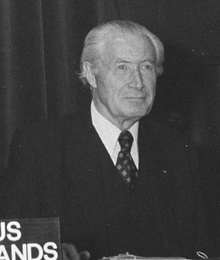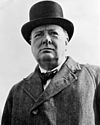|
Duncan Sandys
Duncan Edwin Duncan-Sandys, Baron Duncan-Sandys[1] CH, PC (/sændz/; 24 January 1908 – 26 November 1987), was a British politician and minister in successive Conservative governments in the 1950s and 1960s. He was a son-in-law of Winston Churchill and played a key role in promoting European unity after World War II. Early lifeSandys, born on 24 January 1908 at the Manor House, Sandford Orcas, Dorset, was the son of George John Sandys, a Conservative Member of Parliament (1910–1918), and Mildred Helen Cameron.[2] Sandys's parents divorced in January 1921 when he was 12 years old.[3][4] His mother married Frederick Hamilton Lister in October that year, becoming Mildred Helen Lister. He was educated at Eton College and Magdalen College, Oxford. Early careerSandys entered the diplomatic service in 1930, serving at the Foreign Office in London as well as at the embassy in Berlin. He became Conservative Party Member of Parliament (MP) for Norwood in south London in a by-election in March 1935, at which he was opposed by an Independent Conservative candidate sponsored by Randolph Churchill. In May 1935, he was in effect saying that Germany should have a predominant place in central Europe, so that Britain could be free to pursue her colonial interests without rival.[5] He was a prewar member of the Anglo-German Fellowship. In November 1936 Sandys put forward to the "1912 Club" a "fanciful vision" of England in 1950 (including peace in Europe) .[6] The Duncan Sandys caseIn 1937, Sandys was commissioned into the 51st (London) Anti-Aircraft Brigade, Royal Artillery, of the Territorial Army (TA).[7] In 1938, he asked questions in the House of Commons on matters of national security that reflected his TA experience. He was subsequently approached by two unidentified men, presumably representing the secret services, and threatened with prosecution under section 6 of the Official Secrets Act 1920. Sandys reported the matter to the Committee of Privileges which held that the disclosures of Parliament were not subject to the legislation, though an MP could be disciplined by the House.[8][9] The Official Secrets Act 1939 was enacted in reaction to this incident.[10] Wartime careerDuring the Second World War Sandys fought with 51st (London) HAA Regiment in the Norwegian campaign and was wounded in action; this left him with a permanent limp.[9] His father-in-law gave him his first ministerial post as Financial Secretary to the War Office from 1941 to 1944 during the wartime coalition government. Sandys had been wartime Parliamentary Secretary to the Ministry of Supply. W. A. Robotham who had been in the Ministry as "Chief Engineer of Tank Design" wrote that he was knowledgeable on army matters. Robotham of Rolls-Royce who had headed development of the Meteor tank engine in WWII was surprised and pleased when in 1963 Sandys said "I regard the adoption of the Meteor tank engine as the absolute turning-point in the history of British tank development", at the opening of a Rolls-Royce aero engine factory at East Kilbride (aero engines being Rolls-Royce's main business).[11] From 1944 to 1945 he served as Minister of Works for the remainder of the coalition and in the Churchill Caretaker Ministry. While a minister he was chairman of a War Cabinet Committee for defence against German flying bombs and rockets, on which he frequently clashed with the scientist and intelligence expert R. V. Jones.[12] However, he lost his seat in the 1945 general election. He resigned his TA commission as a lieutenant-colonel the following year.[9] Co-founder of the European Movement
Sandys played a key role in the creation of the European Movement. He established the United Europe Movement in Britain in 1947 following a speech of his father-in-law, Winston Churchill, in Zurich on 19 September 1946 when Churchill had called for the "European family" to be recreated and provided with "a structure under which it can dwell in peace, in safety and in freedom". In 1947, Joseph Retinger, who had been instrumental in setting up the European League for Economic Cooperation in 1946, approached Sandys, then Honorary Secretary of the UEM, to discuss ways the League and the United Europe Movement might cooperate on questions relating to European integration. They decided to call a small conference of existing organisations working for European unity – the European League for Economic Cooperation, the United Europe Movement, the Nouvelles Equipes Internationales, the European Parliamentary Union, and the European Union of Federalists. This took place in Paris on 20 July 1947 where ELEC, the UEM, the EPU and the EUF agreed to establish the Committee for the Co-ordination of the International Movements for European Unity. The EPU did not however subsequently ratify its participation in the committee but the Nouvelles Equipes Internationales agreed to join. In December 1947, the committee was renamed the International Committee of the Movements for European Unity and Sandys was elected its chairman and Retinger its Honorary Secretary. The Committee organised the Congress of Europe, held in The Hague from 7–11 May 1948 with 750 delegates from across Europe. Following the Congress, the International Committee was transformed into the European Movement.[13][14][15][16] Sandys served as a member of the Consultative Assembly of the Council of Europe from 1950 until 1951. Post-war parliamentary careerSandys was elected to parliament once again at the 1950 general election for Streatham and, when the Conservatives regained power in 1951, he was appointed Minister of Supply. For most of his time in that role, his private secretary was Jack Charles. As Minister of Housing from 1954, he introduced the Clean Air Act and in 1955 introduced the green belts. He was appointed Minister of Defence in 1957 and quickly produced the 1957 Defence White Paper that proposed a radical shift in the Royal Air Force by ending the use of fighter aircraft in favour of missile technology. Though later ministers reversed the policy, the lost orders and cuts in research were responsible for several British aircraft manufacturers going out of business. As Minister of Defence he saw the rationalisation (merger) of much of the British military aircraft and engine industry. Sandys continued as a minister at the Commonwealth Relations Office, later combining it with the Colonies Office, until the Conservative government lost power in 1964. In this role he was responsible for granting several colonies their independence and was involved in managing the British response to several conflicts involving the armed forces of the newly independent countries of East Africa.[17] He remained in the shadow cabinet until 1966 when he was sacked by Edward Heath. He had strongly supported Ian Smith in the dispute over Rhodesia's Unilateral Declaration of Independence. He was not offered a post when the Conservatives won the 1970 general election, but instead served as leader of the United Kingdom delegation to the Council of Europe and Western European Union until 1972 when he announced his retirement. The next year he was made a member of the Order of the Companions of Honour. In 1974 he retired from parliament and was awarded a life peerage on 2 May. As the title of Baron Sandys was already held by another family, he followed the example of George Brown and incorporated his first name in his title, changing his surname to Duncan-Sandys.[18] He was created Baron Duncan-Sandys, of the City of Westminster, on 2 May 1974.[1] He was an active early member of the Conservative Monday Club. Personal lifeIn 1935, Sandys married Diana Churchill, daughter of the future prime minister Winston Churchill. They divorced in 1960. In 1962, he married Marie-Claire (née Schmitt), who had been previously married to Robert Hudson, 2nd Viscount Hudson.[citation needed] The marriage lasted until Sandys's death. It has long been speculated that he may have been the 'headless man' whose identity was concealed during the scandalous divorce trial of Margaret Campbell, Duchess of Argyll, in 1963.[19] Sandys died on 26 November 1987 at his home in London.[20] He is buried in the churchyard of St Nicholas in Child Okeford, Dorset. His grave is marked by a horizontal white slab.[21] ChildrenFrom Sandys's first marriage, with Diana Churchill:
From his second marriage, with Marie-Claire Schmitt:
InterestsAmong Sandys's other interests was historic architecture. He formed the Civic Trust in 1957 and was its president; the Royal Institution of British Architects made him an honorary Fellow in 1968, and the Royal Town Planning Institute made him an honorary member. He was also a trustee of the World Security Trust. Between 1969 and 1984 he was President of Europa Nostra and acted for the preservation of the European cultural and architectural heritage. His business activities included a Directorship of the Ashanti Goldfields Corporation, which was later part of Lonrho of which he became chairman. He was therefore caught up in the scandal in which Lonrho was revealed to have bribed several African countries and broken international sanctions against Rhodesia, as well as the "unpleasant and unacceptable face of capitalism" episode involving eight directors being sacked by Tiny Rowland.[22] Career summary
Notes
Further reading
External linksWikimedia Commons has media related to Duncan Sandys.
|
||||||||||||||||||||||||||||||||||||||||||||||||||||||||||||||||||||||||||||||||||||||||||||||||||||||||||||||||||||||||||||||||||||||


